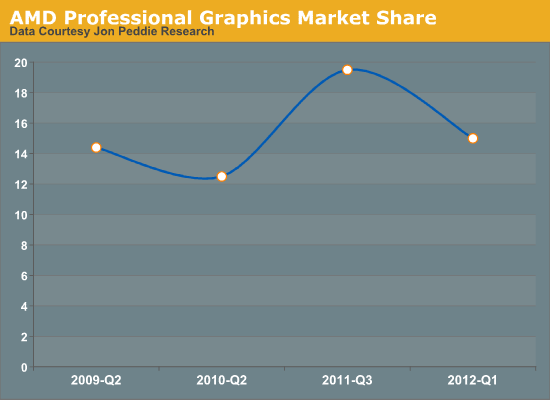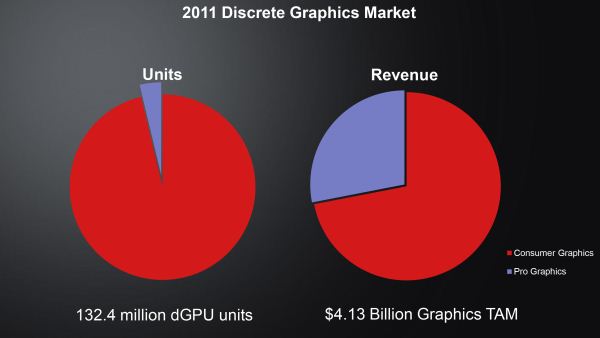The AMD FirePro W9000 & W8000 Review: Part 1
by Ryan Smith on August 14, 2012 4:00 AM ESTSetting the Scene: The Professional Graphics Market
Seeing as how this is our first professional video card review in quite some time, we wanted to spend a bit of time discussing the professional video card market in depth before diving into the features of AMD’s hardware. Because the professional graphics market is not particularly price-sensitive (unlikely the consumer market), how it operates is not particularly straightforward. Understanding the professional graphics market also sets the stage for understanding the importance of the FirePro W series; there’s more at stake than just beating NVIDIA’s cards.
The biggest reason that the professional graphics market is of great importance to NVIDIA and AMD isn’t just that it’s another market for them to sell products in, but because it’s not just another market. As we alluded to in our introduction, going by the volume of products shipped the professional graphics market is tiny. Even looking at revenue it’s far smaller than the consumer market. But what revenue hints at and what financial statements prove is that it’s profitable. Extremely profitable.
Neither AMD nor NVIDIA specifically break out their complete gross margins on a market segment basis – something that would be difficult to do since both rely on the same GPUs and R&D – but they are very straightforward in telling investors about the overall profitability of the professional market segments. To work with a simple example, take NVIDIA’s product lineup, where NVIDIA could profitably sell a GF110 GPU in the form of a GTX 580 at $500. Meanwhile the Quadro 6000 – a card containing the same GF110 GPU – was released at $5000, 10 times the price. Even after factoring in the unique costs of bringing a professional graphics product to market such as driver validation, support, and a higher individual unit cost, the professional graphics market is incredibly profitable. In the GPU market, just like most other technology markets, professionals will pay a much larger premium for specialized hardware.
The end result is that to make a significant profit in the desktop GPU market you need to hold a sizable share of both the consumer market and the professional market. The professional market will provide a low-volume, high-margin income stream, while the consumer market allows manufacturers to spread out R&D costs over a much larger number of products and to sell binned chips that would never meet professional standards.
But what happens if you don’t have a significant share of both the consumer and professional markets? Unfortunately, that would make you AMD.

Our apologies for the inconsistent data. JPR does not regularly release detailed market share data to the public
AMD’s professional graphics presence marks a continuing battle for the company. While in the consumer space they have 25% of the total market (including iGPUs) versus NVIDIA’s 15%, and in the discrete market they have 38% to NVIDIA’s 62%, in the professional graphics market they have only a 15% market share. This is better than the near-10% share they had a few years ago, but it’s below the near-20% share they reached last year, and far below where they would like to be.
As it stands AMD’s graphics division regularly turns out a small profit (in the form of operating income) every quarter, but they’re nowhere near NVIDIA’s profitability. It goes without saying that as a business AMD is always seeking to improve their profitability for their shareholders, however they also need to turn a profit to fund R&D of future products. Just as with CPU development, GPU development costs are continuing to rise with every generation, which makes the professional graphics market and its high margins all the more important. AMD is by no means in dire straits, but long-term a sub-20% market share is not where they want to be. A sub-20% market share means that AMD is struggling to stay relevant.











35 Comments
View All Comments
johnthacker - Tuesday, August 14, 2012 - link
The W7000 has some uses in specific situations, but that's because it's a single slot card. Single slot Radeon HD 7850s (much less 7870s), which also use Pitcairn, are difficult to find; there was one OEM that showed off a design IIRC. Other than that it's hard to see exactly when someone would want these cards.The same generally holds for NVIDIA (the Fermi Quadro cards are cut down GF100 based, so they can be better at compute than their gaming numbers suggest, and the old Quadro 4000 is a single slot card.) Interesting that NVIDIA so far is trying to reserve GK110 for Quadro and Kepler only. We'll see if that works.
Dribble - Tuesday, August 14, 2012 - link
AMD doesn't need to provide compatible, they need to provide better.Bottom line is companies won't change gpu manufacturer. Nvidia works well, has traditionally worked better then AMD and they still have much better driver support (team is much bigger).
There are no AMD fanboys routing for the underdog, you have to provide a clear business reason to change, and "we're almost as good as nvidia in sometimes" isn't it.
CeriseCogburn - Wednesday, August 29, 2012 - link
Compute baby ! amd compute ! compute ! GPGPU ! amd wins! amd wins!(that's all I've heard since 7000 series)
Hey, winzip man.
Pixelpusher6 - Wednesday, August 15, 2012 - link
I really have to question AMD's move here to kill off Firestream and have the FirePro line serve both markets. At the present time this is where they have an advantage on Nvidia. 1TB double precision performance is pretty good even though its only 1/4 of single precision, even clocked low enough to be passively cooled it should still beat Nvidia's best compute card. K10 is not really a compute card at all and to me it seems like they just wanted to get something, anything out until K20. And K20 is by no means a certainty for Q4 2012, my guess is it will be delayed. I just don't have confidence in Nvidia's mastering of the 28nm process yet, especially given the enormous die size of this chip which I've heard presents some unique challenges. And when K20 does come out it will probably be more expensive than their current compute cards.If I were AMD I would re-brand the compute card, drop the Firestream name because of it's association with VLIW, and come out with a new brand to highlight what really makes up GCN...Compute. Does anyone know if HPC clusters use actively cooled cards or only passively cooled? I was under the impression that compute cards generally were clocked a little lower but passively cooled. If that is the case then that rules out using the FirePro W9000 and W8000 in these server clusters. It seems like AMD just conceded this market completely when they finally have a competitive compute GPU to gain a foothold. As someone else noted this market will only be expanding. If AMD wants to only focus on professional graphics I sure hope their drivers will be better than the consumer counterparts.
dtolios - Wednesday, August 15, 2012 - link
When will AMD start improving compatibility with VRay RT and other similar OpenCL apps? All this computational potential remains unused outside benchmarks - at least for the CG world.Radeons are vastly better in OpenGL than GeForce cards, so the switch to FirePro's is way less "mandatory" for such apps. But even if those driver issues were solved, AMD would secure a huge increase of share in the professional CG market which now uses nVidia (yes, mostly gaming cards) almost exclusively.
AG@FirePro - Monday, August 27, 2012 - link
You might imagine that it's in AMD's best interest to work very closely with all the important ISVs in this space - and you would be right! :) Helping our technology partners and the broader software development community implement open-standards-based GPU acceleration in their applications is an area of heavy onging investment for us.Of course, not all apps are written the same. Some applications -especially those written in years past- are architected in a way that makes it challenging to enable the best performance across all the modern GPU options on the market. Proprietary or "hybrid" codebases often make full cross-compatibility quite difficult. can assure you that neither ISVs nor end-users want their toolsets be tied to a particular hardware vendor or proprietary technology base. Unfortunately, it's not always as easy as flipping a switch and sometimes this takes a while. This said, I think it's fair to say that our aim is that very soon, everybody will have the option to run the hardware of their choice in conjunction with their favorite realtime raytracer, physics solver or any other hardware-accelerated toolset.
AMD FirePro cards fully support OpenCL in both hardware and software. Our devices offer certified and acknowledged compatibility and killer performance for a broad range of OpenCL-based applications. The same is true for tons of applications accelerated under OpenGL, DirectX and DirectCompute APIs. Compatibility and reliability are crucial. Nobody understands this more than us.
To this end, we continue to be closely aligned with all the key ISVs in the M&E, DCC and CAD space to help them provide maximum flexibility, choice and value for their end-users.We also continue to refine and expand our range of developer tools (profilers, compliers, debuggers, etc) while at the same time contributing heavily to the open-source community in the form of optimized libraries and other free developer resources.
The OpenCL story gets better every day. Every day, there are new and better OpenCL libraries being written and shared. There are new compiler optimizations being made all the time which allow for faster andmore flexible implementations. More and more software devs are liberating their code and their customers from proprietary APIs. While CUDA-bound apps still provide lots of value for many end-users, the writing is clearly on the wall. The age of proprietary GPU acceleration has begun to yield to a new reality of flexibility and choice for consumers.
This is a good thing, no?
*PS* You may have noticed an announcement about certain new server-side GCN-based FirePro GPU offerings today. Stay tuned. Things are about to get seriously fun up in here.
Adam G.
AMD FirePro Team
CeriseCogburn - Wednesday, August 29, 2012 - link
It's not a good thing because it has not happened, and it doesn't appear it will even in the next decade.It's still proprietary, and is not cross card company compatible, so it's all crap talk.
As we saw amd do after their years of PR bashing, WinZip PROPRIETARY.
It's gonna be all seriously vendor specific up in there for a long, long time.
warpuck - Sunday, August 19, 2012 - link
Does this mean I wont need 2 PCs? one for games and another for graphics. I did notice what appears to be a crossfire connector. I know most companies would not go for PC configuration like that, unless it was in the boss's office. I am one of those independants. I like taking a break when I feel like it. Not having 2 PCs would simplify things for me.peevee - Friday, August 24, 2012 - link
OK, "later this week"? In the review written 8/14. "This" week ended, then "next" week ends today...Death666Angel - Tuesday, August 28, 2012 - link
Hey!No problem about the inconsistent data, but maybe you can present it in a more accurate way? Currently the interval of the X axis is not to scale and the line through the data points makes it seem as though you know the way it progressed in between the data points. I'd rather make a simple bar chart with the intervals showing correctly. It would be a more honest and easy to read diagram. :)
Great article though! :D